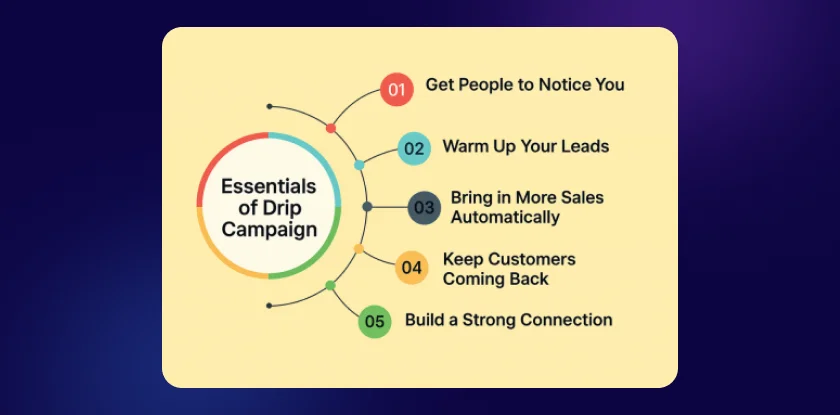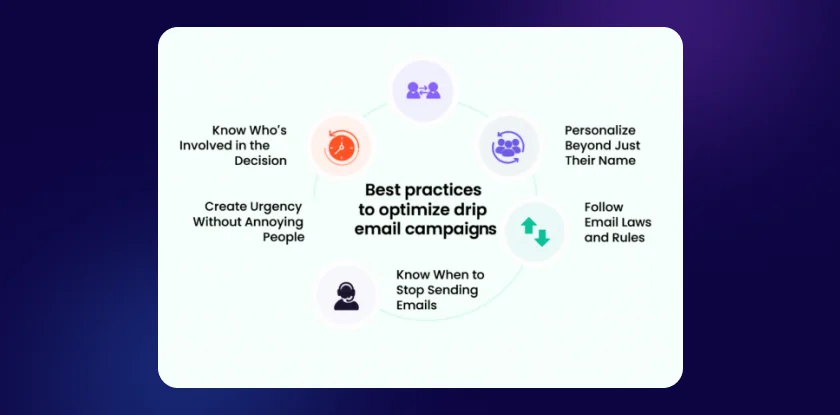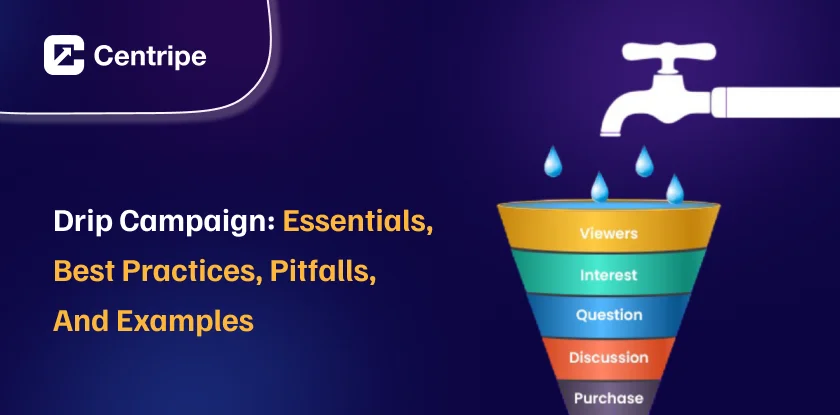A drip campaign is like giving small, friendly reminders over time instead of all at once.
For example, if you own a shop, on day one you welcome a customer, a few days later you share a product they might like, and a week later you send a thank-you with a discount.
Drip campaigns do the same through automated emails, sending the right message at the right time so people remember you and are more likely to buy. In this guide, we’ll see how they work and real examples of businesses using them to turn curious visitors into loyal customers.
What is a Drip Campaign?
A drip campaign is a series of pre-scheduled emails or messages sent to people over time instead of all at once. It’s like giving small, regular updates or tips so they stay connected and interested in what you offer.
These messages are usually automated and sent after certain actions, like signing up, making a purchase, or clicking a link. It is to gradually earn their trust, have your brand at the back of their minds, and get them to become customers.
Many businesses run drip campaigns as part of a bigger email marketing automation strategy. If you’d like to learn more about how automation works, click here to read about it.
Why Drip Campaigns Are Essential for Modern Marketing

The drip emails will ensure more sales, happy customers, and save time since follow-ups, trust, and connection will be through automated emails.
1. Get People to Notice You
It often takes eight interactions before someone buys from you. Drip emails make this easy by sending useful, engaging messages automatically over time.
This keeps your brand fresh in people’s minds without you manually following up.
2. Warm Up Your Leads
You cannot just go and make everyone purchase, at least some people need time to believe you. Drip campaigns allow directing them through the steps, as each email seems to be personal and applicable.
It costs no more effort to do it to hundreds or thousands at a time.
3. Bring in More Sales Automatically
Automated drip emails run 24/7, and they send the right message to the right person at the right time.
This increases the open rates and conversions as you attend to other things. It is similar to having a salesperson who works 24 hours a day and never says a word.
4. Keep Customers Coming Back
It costs five times more to get a new customer than to keep one. Drip campaigns help you stay in touch with tips, offers, and updates even after a purchase.
This builds loyalty and encourages repeat business naturally.
5. Build a Strong Connection
Consumers will purchase products of a brand that they trust and love. Sending timely, useful content will cause them to think of you as an expert.
This will, over time, make customers become your loyal fans and refer you to others.
8 Drip Campaigns Every B2B Business Should Use
Think of a drip campaign like a slow drip of water from a tap, but instead of water, you’re sending small, planned emails to people over time. These emails build trust, answer questions, and help people buy or use your product.
Here are 8 types you should know about:
1. Welcome Emails
- Why: First impressions matter.
- How many: 3–5 emails in the first 1–2 weeks.
What to say:
- Tell your story (who you are).
- Show what makes you special.
- Share a quick, easy tip they can use today.
- Add proof (like customer reviews) so they trust you.
2. Lead Nurturing (Warm-up Emails)
- Why: To slowly guide people toward buying, without being pushy.
- How many: 5–10 emails over 1–2 months.
What to say:
- Share helpful knowledge.
- Case studies (real stories of success).
- Easy product demo videos.
- Tools like ROI calculators (showing money saved or earned).
3. Customer Onboarding (Getting Started)
- Why: Help customers actually use what they bought.
- How many: 7–14 emails over the first few months.
What to say:
- Step-by-step setup guides (easy to follow).
- Tips from other users.
- Celebrate small wins (like “Congrats on your first setup!”).
- Remind them that support is always available.
4. Re-engagement (Win Back Lost Customers)
- Why: To bring back people who stopped using or opening your emails.
- How many: 3–5 emails in a few weeks.
What to say:
- “We miss you” (in a cool, not desperate way).
- Show what’s new since they left.
- Offer a small discount or deal.
- A final “breakup” email sometimes works.
5. Post-Purchase Follow-ups
- Why: Keep customers happy even after buying.
- How many: 4–6 emails over about a month.
What to say:
- A real, heartfelt thank you.
- Tips on how to get the most from what they bought.
- Show useful add-ons (not random upsells).
- Ask for a review when they’re happiest.
6. Abandoned Cart Recovery
- Why: Save sales when people add items to cart but don’t buy.
- How many: 3–4 emails in the first 3 days.
What to say:
- Friendly reminder about their cart.
- Add urgency (only if real).
- Show other happy customers.
- Maybe a small discount if they still don’t buy.
7. Upsell & Cross-sell Emails
- Why: To get existing customers to buy more (without being annoying).
- How many: 3–5 emails, sent based on how they use your product.
What to say:
- Show features they’re missing out on.
- Bundle deals that really save them money.
- Real stories from customers who upgraded.
8. Event-Triggered Emails
- Why: To send the right email at the right moment.
- How many: Depends on the event.
What to say:
- Make it personal, match the event.
- Give timely offers that make sense.
- Show clear next steps.
Drip Campaign Platform Comparison
| Platform | Best For | Starting Price | Key Features | Limitations |
|---|---|---|---|---|
| HubSpot | Mid-market B2B | $800/month | Strong CRM integration, visual workflows, advanced analytics | Can get expensive with scale (very expensive) |
| ActiveCampaign | Small to mid-size teams | $49/month | Excellent automation, good deliverability, predictive sending | Learning curve for beginners (but worth it) |
| Marketo | Enterprise | Custom pricing | Advanced lead scoring, multi-touch attribution, ABM features | Complex setup, requires expertise (and patience) |
| Mailchimp | Small businesses | $20/month | User-friendly, good templates, basic automation | Limited advanced features (you get what you pay for) |
| Pardot | Salesforce users | $1,250/month | Deep Salesforce integration, B2B focused, ROI reporting | Expensive, Salesforce-dependent |
6 Best Practices for Drip Campaign

1. Know Who’s Involved in the Decision
In B2B sales, it’s rarely one person making the call; usually, it’s a group.
You might have IT staff checking security, managers looking at profits, daily users worried about changes, and legal teams checking compliance.
Make sure your emails speak to each group’s needs so everyone feels confident moving forward.
2. Personalize Beyond Just Their Name
Using someone’s name is not enough. Mention their company in examples, highlight benefits for their specific role, and adjust your “call-to-action” depending on where they are in the buying journey.
Share case studies that are actually relevant to their industry or problem, not just generic ones
3. Make Your Emails Work in Dark Mode
Many professionals now use dark mode on their devices. Test your emails in both light and dark versions.
Use logos with transparent backgrounds, colors that stand out clearly, and avoid pale text on pale backgrounds that’s hard to read.
4. Create Urgency Without Annoying People
You don’t need to push too hard to get attention. Instead of endless discounts, offer time-limited bonuses, announce upcoming program start dates, share sneak peeks of new features, or show results that similar customers are getting.
This builds excitement without pressure.
5. Know When to Stop Sending Emails
Too many emails can turn people off. Keep your drip series short, around 10 to 12 messages. Give them an option to pause emails if they’re not ready yet.
Let them easily choose what they want to receive, and slowly learn more about them without asking too many questions at once.
6. Follow Email Laws and Rules
Always make it easy for people to unsubscribe. Get permission before emailing people in regions with strict rules like the EU (GDPR).
Keep records of when and how they agreed to get your emails. Also, be clear on how long you’ll keep their data and store it safely.
Common Pitfalls and How to Avoid Them
| Pitfall | The Problem | The Fix |
|---|---|---|
| Over-Automation | Your emails sound like they were written by a robot. | Add a human touch—use personal PS notes, share timely updates, and let your real personality shine through. |
| One-Size-Fits-All Messaging | Generic content that puts everyone to sleep. | Create separate email tracks for different audiences. Yes, it’s more work, but it’s better than watching your campaign fail. |
| Ignoring Mobile Optimization | Many B2B readers check email on their phone, often during meetings. | Use responsive templates, test on real devices (not just previews), and make sure buttons are easy to tap. |
| Set-and-Forget Mentality | Set-and-Forget Mentality | Review your campaigns every quarter and make improvements. Put it in your calendar so it actually happens. |
Real World Drip Campaign Example
Type of Company: Cybersecurity solutions provider
What they did:
- Week 1 – Shared helpful insights on the latest security threats.
- Week 3 – Sent an in-depth whitepaper and followed up based on reader interest.
- Week 5 – Invited leads to a live webinar with reminder emails.
- Week 7 – Shared a case study and offered a free product demo.
- Week 10 – Sent a high-level summary for decision-makers and connected them to sales.
The Result: Sales-qualified leads tripled compared to before.
Conclusion
Drip campaign does not concern filling Inboxes, it is concerned with creating consistent, real relationships. With the right timing, personalization, and value, they can turn cold leads into loyal customers while saving you time.
Start small, keep improving, and let your emails work quietly in the background to grow your business day by day.
